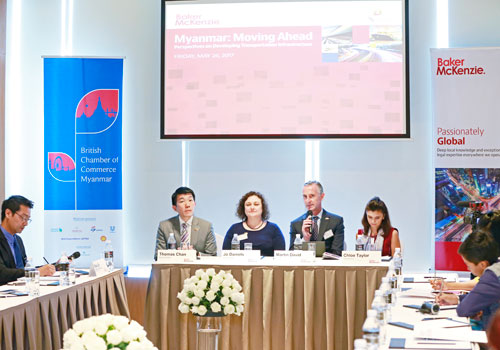Transport experts encourage Myanmar to adopt PPP model
AS Myanmar and its cities are developing the transport infrastructure, experts have advocated the adoption of the public-private partnership (PPP) model to speed up the development, according to a transport conference last week.
International law firm Baker McKenzie, in collaboration with the British Chamber of Commerce Myanmar, hosted the conference “Myanmar: Moving Ahead Perspectives on Developing Transportation Infrastructure” in Yangon on May 26 in order to discuss the opportunities and challenges in developing the country’s transport sector.
The event covered a wide range of topics, including policy, PPP frameworks, concessions, financing, and structuring of various types of transport projects such as railroads, roads and ports.
Deputy Minister for Transport and Communication U Kyaw Myo said that transport is crucial to Myanmar’s economic development and the government will focus on this.
He added that the transport infrastructure is essential for the country to create employment opportunities and encourage trade with other countries.
As for ways to move forward in developing the country’s transport infrastructure, Baker McKenzie’s managing partner, Jo Daniels, provided key recommendations.
“It is important for Myanmar to be flexible in the approach to public-private partnerships, as different forms of PPPs may be better-suited to different transport projects.
“I would encourage the Myanmar government to not wait for a PPP law but instead begin promoting PPPs as a method of addressing the infrastructure gap in Myanmar,” she remarked.
Jo Daniels also discussed international best practices in PPPs, including the need to conduct a rigorous feasibility study to select the most appropriate PPP model for a project.
Public-private partnerships between a government agency and private-sector company can be used to finance, construct and operate projects, such as public road networks, transport systems and night markets.
The Yangon Bus Public Company (YBPC) is a PPP project, which was set up with K10 billion from the government and K2.5 million from five private companies. Similarly, the government originally planned to use PPP to operate the entire Yangon Bus System (YBS), but has not yet been able to do so.
The Myanmar government wants to implement a PPP system in all of the sectors, including transport.
Other examples include “BRT Lite”. The “BRT Lite” scheme is based on a plan drawn up in 2013 by the Japan International Cooperation Agency (JICA) for a system intended to cover much of the city. The less-ambitious version was selected because it cost less than the original plan.
“In implementing a PPP, the government needs to apply the most suitable model with Myanmar, and make sure it meets the relevant regulations.
 Martin David from Singapore-based Baker McKenzie Wong & Leow praised the Myanmar government’s efforts to develop infrastructure in collaboration with the private sector. Photo – Supplied
Martin David from Singapore-based Baker McKenzie Wong & Leow praised the Myanmar government’s efforts to develop infrastructure in collaboration with the private sector. Photo – Supplied
“Some of the regulations need to be modernised and reformed. We need to form the best PPP model and implement an operational framework which best match the current economic landscape. Doing so will be beneficial to us,” U Htun Aung Thin, general manager at Myanma Railways, said.
U Htun Aung Thin said that by tackling the issues discussed at the conference, the country can create a context in which the transport sector can develop effectively.
Various speakers at the conference emphasised the importance of a close collaboration between public and private sectors in developing complex infrastructure projects in emerging markets.
“There needs to be a partnership which lasts over time and adapts to the rapidly changing economic landscape.
“I believe the government of Myanmar is approaching the country’s infrastructure needs in the right way by investing time and effort now to develop the right foundation upon which future infrastructure can develop in collaboration with the private sector,» said Martin David from Singapore-based Baker McKenzie Wong & Leow.
U Htun Aung Thin also highlighted the need to modernise.
“Regarding the infrastructure, we have to upgrade and modernise.
“For example, in railroad transport, we need to use electric-powered trains to reduce air pollution and transport costs. These are very important so we need to implement the reforms,” he explained.
The Yangon Region government has carried out a number of reforms in the public transport system.
Apart from the YBS, the government is also launching the Yangon water bus service next month.
Last week, the government said it had chosen the company which would operate the water bus service on the Hlaing River and Nga Moe Yeik Creek.
Railway is another topic which speakers at the conference tackled. Commuters are using the circular train as an alternative to the bus system. Hence, there are many changes necessary to develop an efficient railway network in Myanmar’s commercial hub.
After the government has implemented the YBS, the number of passengers taking the circular train increased. For railway transport, service and punctuality are both crucial.
“Most commuters place a heavy emphasis on their time so they have switched to circular trains. We must make improvements accordingly,” U Htun Aung Thin added.
Source: http://www.mmtimes.com/index.php/business/26191-transport-experts-encourage-myanmar-to-adopt-ppp-model.html


 Thailand
Thailand




